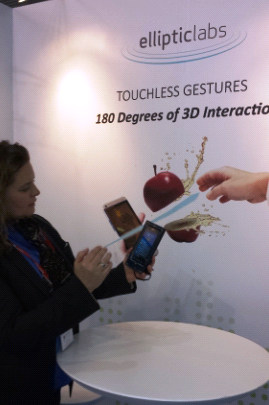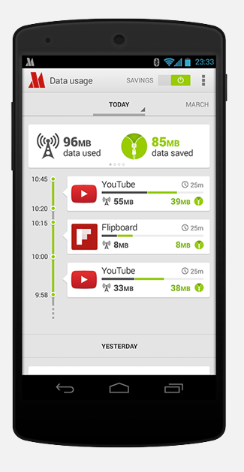In the first part of my multi-part series on things, companies and people that got the juices flowing at the recently concluded Mobile World Congress (MWC), the focus was on the creation of Israeli-based Essence and the ground breaking work they are doing in creating the nascent category of “Smart Care.”
In this installment the focus is going to be on things I saw or heard that are potentially game changers and also aligned perfectly with the show’s theme of “What’s Next.” While all of the press releases gave a flavor of what lies ahead, the event really is a place for sensory over-load and therefore it only seems appropriate to give a short rundown of the top five companies whose capabilities really epitomized the saying, “Seeing is Believing!” And, in this case hearing is as well.
Fraunhofer and why voice quality matters
A good place to start is with my visit to the Fraunhofer booth where HP Baumeister, Director, Mobile and Communications Markets Audio and Multimedia at Fraunhofer USA and his colleagues quite frankly made me a believer in the notion that voice and video quality, whether over a fixed line phone or especially over a mobile, still matters.
For those unfamiliar with Fraunhofer this is an organization you need to know. Based in Germany, it is Europe’s largest application-oriented research organization. It does contact research with private technology companies and governments through a workforce of 23,000 (mostly scientists and engineers) and operates 67 institutes and research units. It has an annual budget of roughly $2.7 billion of which 70 percent comes from contract research and roughly 30 percent from German federal and Lander governments. In short, name the technology and Fraunhofer is likely at the leading edge of helping push it forward and assisting in product realization.
What HP wanted me to hear was the impact of the Fraunhofer Institutes for Integrated Circuits Full-HS Voice codec and the AAC family of codecs for high-fidelity audio and video conferencing. As HP explained, “One of the things that has held back teleconferencing in general and video conferencing in particular has been quality. With things like WebRTC and VoLTE on the way, the fact of the matter is not only does voice still matter, but quality voice will be a differentiator.”
With headphones on, and HP at one end of the booth and his associate Mandy Garcia at another and me in the middle, with the push of a button we initiated a three-way audio conference. The experience was a revelation that can only be likened to seeing the difference between regular TV and 1080p HD for the first time. While the Full-HD Voice codec runs at similar bit-rates to current phone services, the clarity of communications was astounding and even though the other two parties were in eye shot, there was no perceptible latency.
In short, this was a real ear-opener, and I now think that quality can and likely will be a differentiator in the market. I also think that based on not just what I heard, but also saw in terms of video teleconferencing (what I like to think of as “visual voice”), Fraunhofer at the plumbing level has made what has been a major obstacle for people using video more, bad quality, a thing of the past.
I can also tell you, without going into detail, that a visit to an acoustic chamber allowed me to experience complete surround sound without speakers being placed all around the chamber to create the effect. The possibilities of the use of the technology employed are substantial to say the least.
Elliptic Labs breaking sound barriers in gesture recognition computing
I will admit that the headline above is a bit misleading the sound barrier I am referring to is the use of ultrasound instead of touch or infra-red for enabling computers to work. The company at the forefront of this technology is Palo Alto, CA-based EllipticLabs, and in this case it was not about just seeing but about gesturing. EllipticLabs’ CEO Laila Danielsen put me through the paces, and she can provide you with the basics in a short video on their site.

Yes, the company is working in an exciting area. Touchless gesture recognition based on leveraging the surround capabilities of ultrasound has some interesting applications. In general, as the video highlights, it can enable more natural interactions by ordinary folks. As if not more importantly, people working in places like clean rooms, where touching without a glove on renders the typical touch-based screen non-cooperative, can be more productive. Detection of ultrasound waves and use of the EllipticLabs engine make this possible.
That would be exciting enough for a variety of applications. However, what I got to play with at MWC was a new capability of layering. What this means is that EllipticLabs has figured out how if I wave my hand over the top of a screen my gesture will be recognized, but if I wave it in the same proximity but on the side or below the screen it will not. They have literally fenced in sound. This pushes the bar high, and is one of the reasons the company was one of the Ceatec 2013 Innovation Award winners.
Opera Software visualizes and optimizes surfing
There are already 350 people who are users of Opera Software’s browser. What you may not know is that because we have all become data plan obsessed, Opera has a new app, Opera Max beta, a cloud-based capability for your smartphone or tablet that gives you visibility into your usage of favorite and not so favorite websites and save you big money.

Source: Opera Software
Pal Unanue-Zhal, Senior Communications Manager for Opera, had me download the app, and within seconds I could see what I was using. As Zhal explained, “A real benefit here is that Opera Max compresses pictures and video meaning you use less of your data plan with a hardly perceptible difference in quality. The savings can add up fast.” In addition, Opera Max can detect when you are roaming or out of your network and prevent apps from using any expensive data, and you can set it so that any app using the mobile data plan is blocked unless you are on Wi-Fi. All I can add is that if you try it you will like it.
Separating multiple personas is key
It is always a revelation to see something really new for the first time. Such was the case of being walked through the paces of Ottawa, Canada-based Graphite Software’s first public demonstration of Secure Spaces.
What is Secure Spaces? It is a multi-persona solution for Android smartphones and tablets. As Alec Main, CEO of Graphite Software, explained, “Secure Spaces system-level virtualization enables multiple isolated virtual machines on a single device, which enables many uses cases from personal privacy, BYOD to mobile marketing.”
Designed from IT’s perspective, Secure Spaces is a virtualization solution that provides high levels of security and does not require the modification of apps like application container approaches. In addition, as Main described, unlike hypervisor approaches there is no integration or performance overhead of launching multiple operating system copies.
He added, that another benefit of being able to securely separate those disparate personae using Secure Spaces on our BYOD devices is that it is mobile device management (MDM)-agnostic. This translates into an adroit solution that supports delegation of work space management to corporate IT or MDM resources, while also providing users complete control of their various profiles and data.
Secure Spaces allows for multiple personal spaces on a single device to separate accounts and personal data and prevents other apps, that demand too multiple permissions, from intruding. Hence, it prevents the problems of unintended and potentially dangerous bleeding of personal and corporate apps and data.
Looking down the road a bit, it is possible to see where Secure Spaces could be leveraged to created branded apps from various companies that can be used without fear of them contaminating other persona. The use cases that such a capability can enable is substantial with IT having the visibility and manageability it requires to mitigate risks, and users the peace of mind and control they want when using their BYOD devices anywhere at any time.
Main noted that Secure Spaces is currently in trial by device OEMs and mobile service providers.
Siklu makes small cell deployment easy
Last, and certainly not least of potential game changing things I saw comes from Petach Tikva, Israel, based Siklu, a leading supplier of millimeter wave backhaul systems that operate in the 50, 60, 70 and 80 GHz (E-band) frequencies. The company has enhanced its street-level EtherHaul millimeter wave backhaul systems with a suite of tools that includes auto-alignment and zero touch commissioning.
Why is this important? The reason is simple. It allows installation to be performed by non-telco installers in 15 minutes or less. And, when they say simple they mean it. Installation of a small cell with backhaul connectivity literally is a case of point and shoot to get things up and running. Shahar Peleg, Director of Product Management and Marketing at Siklu, demonstrated the ease of installation and even I with minimal training am confident of my ability to install the solution.
Peleg noted that, “We wanted to empower the everyday installer to deploy millimeter wave systems without any specialized telco knowledge.” As we discussed, with small cell deployment now a matter of necessity for mobile service providers being able to bend the curve on installation costs is critical. In fact, mobile operators are looking to offload installation duties from highly skilled and paid field technicians to third-parties without the fear of installation going bad.
Without going into the technical details, the demonstration highlighted the value of the new auto-alignment tool which enables Zero-touch commissioning and how SON (Self-Organizing Network) integration gives operators activation and management from a central location.
I also want to make note of the company’s ETHERHAUL-600 V-band Radio which packs a punch. This small cell backhaul device literally is ideal for street-level deployment for a variety of reasons including its scalable gigabit throughput capabilities and a form factor that is a little bigger than the size of your hand and again simple to install. In places where space is at a premium, the latter point about size mattering is non-trivial.
Peleg noted that, “This makes millimeter waves an even more compelling choice for urban backhaul, with their gigabit throughput, interference-free spectrum, and now, low installation and maintenance costs.” Indeed, for getting to those hard to reach places, especially when fiber is not available or is very expensive, E-band backhaul is going to be a popular way to go. Getting it right the first time, fast and easy is just the thing to help operators accelerate their deployments.
So there you have just a few things that really were eye and ear openers. Stay tuned for the next installment where I will look at some exciting developments in the areas of M2M, multi-factor authentication and a few addition surprises.
Edited by
Cassandra Tucker
 QUICK LINKS
QUICK LINKS